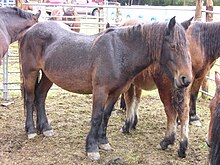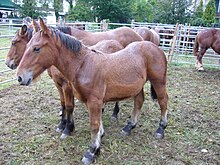 | |
| Conservation status | |
|---|---|
| Other names |
|
| Country of origin | Spain |
| Distribution | Navarre |
| Standard | Asociación de Criadores de Ganado Equino Jaca Navarra |
| Use | |
| Traits | |
| Weight |
|
| Height |
|

The Jaca Navarra (Basque: Nafarroako zaldiko), or Navarrese Horse, is a Spanish breed of small horse from the autonomous community of Navarre in the north-eastern part of the country. In 2013 it was listed in the Catálogo Oficial de Razas de Ganado de España in the group of autochthonous breeds in danger of extinction. The total population of the Jaca Navarra has been variously estimated at 350 (in 1999), 250 (in 2000), and 240 and decreasing (in 1997). In April 2011 the total population was reported to be 899, all of which were in Navarre. In 2000, and again in 2007, it was listed by the FAO as endangered.
A breeders' association, the Asociación de Criadores de Ganado Equino Jaca Navarra, was formed in 1999, and a stud-book opened in 2001. The conservation and reference herd kept in semi-feral conditions at the Sabaiza estate contains all but a few examples of the breed.
Names
In Spanish, this breed is also known as the Poney Navarro, Caballo Navarro, Caballo Vasco-navarro, Caballito de Andía, Caballito de las Améscoas or Caballito de la Barranca, and was in the past also known as Jaca de Montaña, Raza de Pamplona or Raza Pamplonica.
The word jaca has an unusual history, from Old Spanish haca, itself from Old French haque, which in turn is ultimately derived from the English place-name Hackney, a place famous for its horses.
Use
The Jaca Navarra may be used as a light draught horse. It is reared for meat, and may be used in conservation grazing.
References
- ^ Barbara Rischkowsky, Dafydd Pilling (editors) (2007). List of breeds documented in the Global Databank for Animal Genetic Resources, annex to The State of the World's Animal Genetic Resources for Food and Agriculture. Rome: Commission on Genetic Resources for Food and Agriculture, Food and Agriculture Organization of the United Nations. ISBN 9789251057629. Archived 23 June 2020.
- ^ Breed data sheet: Jaca Navarra / Spain (Horse). Domestic Animal Diversity Information System of the Food and Agriculture Organization of the United Nations. Accessed December 2022.
- Miguel Fernández Rodríguez, Mariano Gómez Fernández, Juan Vicente Delgado Bermejo, Silvia Adán Belmonte, Miguel Jiménez Cabras (editors) (2009). Guía de campo de las razas autóctonas españolas (in Spanish). Madrid: Ministerio de Medio Ambiente y Medio Rural y Marino. ISBN 9788449109461.
- Ganaderia: Clasificación de Razas (in Spanish). Ministerio de Medio Ambiente y Medio Rural y Marino. Archived 13 February 2013.
- ^ Raza Jaca Navarra (in Spanish). ITG Ganadero. Archived 13 July 2011.
- J. Cañon, M.L. Checa, C. Carleos, J.L. Vega-Pla, M. Vallejo, S. Dunner (2000). The Genetic Structure of Spanish Celtic Horse Breeds Inferred from Microsatellite Data. Animal Genetics. 31 (1): 39–48. doi:10.1046/j.1365-2052.2000.00591.x
- ^ Beate D. Scherf (editor) (2000). World Watch List for Domestic Animal Diversity. Rome: Food and Agriculture Organization of the United Nations. ISBN 9251045119.
- Ganaderia: Raza equino caballar Jaca Navarra: Datos Censales (in Spanish). Ministerio de Medio Ambiente y Medio Rural y Marino. Archived 11 August 2011.
- ^ Ganaderia: Raza equino caballar Jaca Navarra (in Spanish). Ministerio de Medio Ambiente y Medio Rural y Marino. Archived 11 August 2011.
- Diccionario de la lengua española (in Spanish). Real Academia Española. Accessed April 2011.
- Valerie Porter, Lawrence Alderson, Stephen J.G. Hall, D. Phillip Sponenberg (2016). Mason's World Encyclopedia of Livestock Breeds and Breeding (sixth edition). Wallingford: CABI. ISBN 9781780647944.
Further reading
- Alberto Pérez de Muniáin Ortigosa, Martín Villanueva Vergara, Satur Napal Lecumberri (2007). Nuestros caballos: la Jaca Navarra y el Burguete (in Spanish). Pamplona: Editorial Evidencia Médica. ISBN 9788493486051.
| Horse breeds of the Iberian peninsula | |
|---|---|
| Horse breeds thought to originate wholly or partly within Portugal and Spain. Some have complex or obscure histories, so inclusion here does not necessarily imply that a breed is predominantly or exclusively Iberian. | |
| Basque domestic animal breeds | |
|---|---|
| |
| Ass | |
| Cattle | |
| Dogs | |
| Horses | |
| Goat | |
| Poultry | |
| Pigs | |
| Sheep | |
This horse breed–related article is a stub. You can help Misplaced Pages by expanding it. |